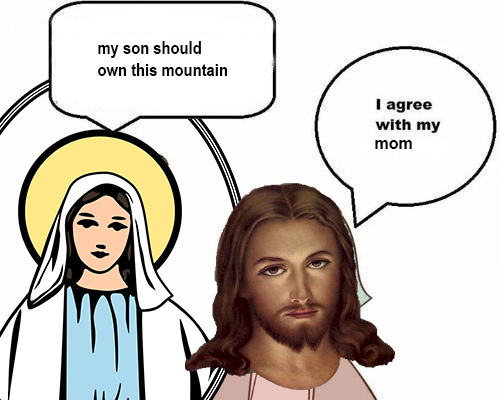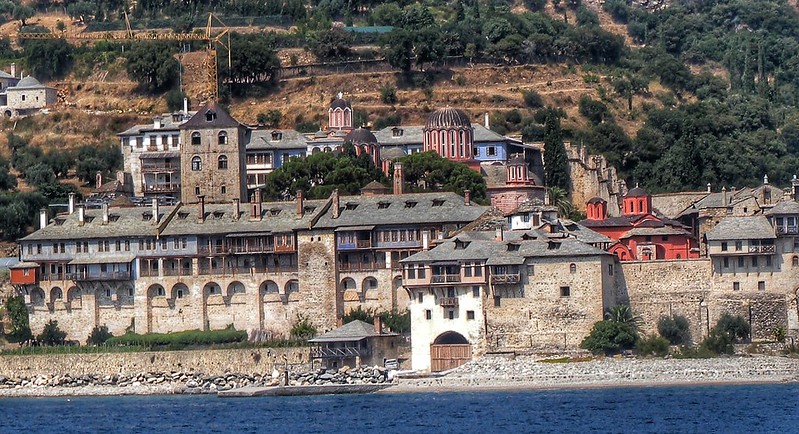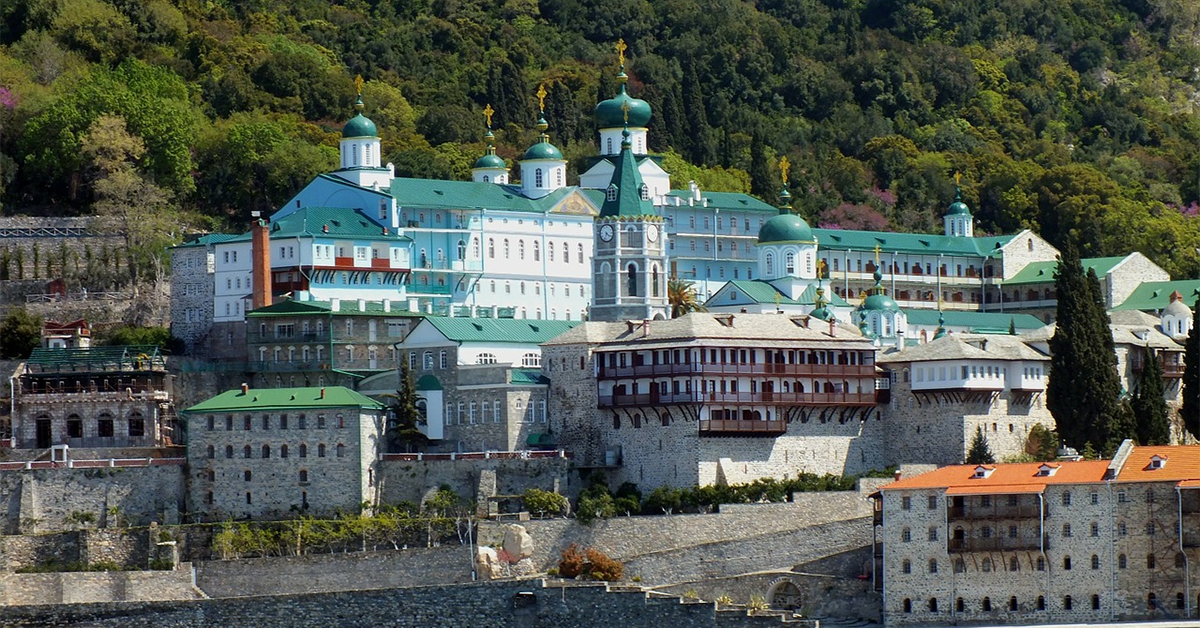Every year, as many as 40,000 visitors take a ferry to a cordoned-off section of Greece’s Halkidiki peninsula. If they’re coming from within the European Union, passports are optional. Penises are mandatory.
This spit of land is Mount Athos, named after the big ol’ mountain that dominates its terrain. Beyond the border, the rest of the Halkidiki Peninsula is part of the Greek Province of Central Macedonia. Mount Athos isn’t. It’s not part of any of Greece’s provinces. Instead, it’s the country’s only autonomous region, meaning local leaders are in complete control of internal affairs.
In other European countries (and abroad), autonomous regions exist mostly to offer home-rule to ethnic minorities without the burden of creating an entirely new nation. Mount Athos is different. The only minority groups its people belong to are beard havers and funny hat wearers. That’s because Mount Athos is a religious enclave ruled directly by the Ecumenical Patriarch of Constantinople, the closest thing Eastern Orthodox Christians have to a Pope.

Affairs in the “Autonomous Monastic Republic of the Holy Mountain” are highly traditional. All full-time residents are monks living in one of twenty monasteries that dot the peninsula’s long coastline. They’re also all men. Women aren’t allowed in the monastic republic, and they haven’t been since the beginning. Feminists rest assured, it’s not bias against human women in particular that keeps them locked out — female animals are also banned, meaning eggs and dairy products have to be imported.
Mount Athos’s history as an established religious site goes back over a thousand years, but local lore takes the mountain’s Christian history even further. Legends retold by the local monks claim that Jesus’s mom, the Virgin Mary, landed there at some point when a gust of wind separated her boat from its intended path.
Mary’s inconvenience was offset by the beauty of her captor peninsula, and she was reportedly so enraptured by it that she decided that it should be set aside for her son. Jesus, not one to refuse a 130 square mile land grant, accepted.

It’s out of respect for Mary, modern inhabitants explain, that women are barred from entry, this being one of history’s most consequential examples of the “thanks, but no thanks” doctrine.
Independent hermits have made homes of Mount Athos since the sixth or seventh centuries, but organized religious life didn’t exist there until 963 when St. Athanasius the Athonite founded the Great Laura, the first of many monasteries along the holy shore.
Athos’s existing band of comfortably lonely hermits weren’t particularly psyched about monastic life and resisted it for as long as they could. Unfortunately for the ragtag group of men focused on just hangin’ out, thinkin’ about God, Athanasius had the support of the Byzantine Emperor, John I Tzimisces, who awarded the peninsula its first legal charter and thereby promptly bade the hermits to shut the hell up and accept his boy.
The monasteries held stable through the following centuries, though not without significant strife during wars such as those that saw the Byzantine Empire fall to the invading Ottoman Turks. The religious sanctuary held on as a bastion of Eastern Orthodoxy, attracting visitors and monks from beyond Greece’s borders.
By the 1800s, this notable center of Orthodoxy had caught the eye of the Russian Empire. Eastern Orthodoxy was the empire’s largest religious denomination by far, and when the Byzantine Empire fell centuries prior, Russian leaders set out to establish themselves as their successors. Just as the Emperors of Byzantium (officially the Eastern Roman Empire or simply the Roman Empire) inherited Rome’s tradition of calling their leader Caesar, the Russian emperors adopted the title Czar.
The Czars saw a presence in Mount Athos as another way to cement their daddy role over the Eastern Orthodox faith, and set quickly to establishing and furnishing monasteries of their own across the peninsula. Imperial Russian interest persisted for a century, and in 1913 the czar Nicholas II made a power play by sending thousands of Russian monks to Mount Athos and officially demanding that it be afforded independence. Greece capitulated and bestowed autonomy on the peninsula, but dreams for total Russian imperial domination ceased existing when the Russian Empire itself did in 1917.
Mount Athos’s current constitution was made law in 1924, and the active Greek Constitution of 1975 guarantees the monastic republic’s autonomy.

Today, Mount Athos is a relic of its thousand-year past punctuated by elements of modernity; SUVs now drive through the coastal streets where serene monks tap away on smartphones. While some of the rules have been relaxed (men once had to be able to grow beards to enter the peninsula, to prove they aren’t secretly women), others, like the blanket vagina veto, have remained. And while an exception to the “no female animals” rule is made for wild animals (not enough monks to staff a cloaca-focused border patrol), human women receive no such leniency. A 1953 visit by a sneaky woman masquerading as a man prompted the Greek parliament to pass a law imposing a year-long prison sentence on any foul wench rowdy enough to set foot on the peninsula with tits in tow.
The republic’s history of enforcing its nuclear “No Girls Allowed” policy once extended to eunuchs (castrated men) for the same reason as the exclusion of young boys and the beardless — they could be secret women. It may seem extreme at first, but you have to remember that these guys don’t know what a vagina looks like, so you really can’t be too cautious.
The defense of the Estrogen Exclusion Act is so important to the island’s residents that feelings of fear and resentment gripped Mount Athos when Greece agreed to join the European Union’s border-free Schengen Area. The monks, convinced that the move would let Europe strong-arm Greece into complying with gender equality legislation, declared it the work of Satan. Today, construction cranes line the skies around Mount Athos, part of a series of extensive restoration projects funded by the (Satanic) European Union.
As the monks lean away from Europe, they move toward an old friend. Like a long-unseen pal fresh out of a deep depression, Russia’s back, baby, and less Soviet than ever. Of the 40,000 people who visit Mount Athos a year, as many as half are Russian. When Russian President Vladimir Putin visited, he enjoyed the fervent adoration of the monks, scaring the shit out of some local Greeks.
Russia’s revived presence in Mount Athos is attributable in part to a 2018 decision by the Patriarch of Constantinople (the pseudo-Pope) to grant autocephaly to the Ukrainian Orthodox Church. To explain in words I you can understand, the Patriarch of Constantinople is only sorta like the Pope because, unlike the Catholic Church, Eastern Orthodox Christianity isn’t one unified church but several mostly-independent churches operating together. The Patriarch of Constantinople is considered “first among equals”, but does not generally direct activities in sister churches, preferring to let his bearded brethren go with the flow.
But, in 2018, amid the ongoing Russo-Ukrainian War, the current Patriarch of Constantinople, Bartholomew I, formally recognized the Ukrainian Orthodox Church as autocephalic, promoting it to the status of one of those sister churches not subsidiary to any other. Until then, the Ukrainian church had always been under the Russian church’s command, and whether or not Bartholomew had the right to interfere in Russian affairs was publicly questioned.
The Russian Patriarchate’s response and condemnation was swift. Today, some of Athos’s Russian monasteries openly distribute newspapers that disparage Bartholomew and laud the Russian Patriarch, Kirill. I hate it when Greek Dad and Russian Dad fight.
Mount Athos is a weird place. Its citizens wake up and pray for six hours a day. They use an outdated calendar that doesn’t properly adjust for leap years as their primary method of timekeeping. The Greek government appoints a representative to govern the republic, but practical matters are handled by a religious council, making Athos one of the world’s last remaining theocracies.
More recently, the monks have developed a robust tourism economy centered around the sale of locally-produced goods like religious icons that sell for over ten thousand dollars and special handcrafted woodworking products made with migrant labor. Even more recently, the Greek government has complained about having a hell of a time getting these guys to consider the Covid vaccine. Some of the monks have agreed, but the official position of the standing majority is that the shot is the work of Satan.
Visitors were temporarily barred from the peninsula during the pandemic, but operations have recently reopened. In other words, if Mount Athos sounds like the sort of place you’d like to visit, there’s hardly a better time to pack your bags and your balls and see what Europe’s last woman-free theocracy has to offer.
Read More
- Mount Athos from Encyclopedia Britannica
- Mount Athos from the UNESCO World Heritage Center
- Mount Athos, a Male-Only Holy Retreat, Is Ruffled by Tourists and Russia by Neil MacFarquhar for The New York Times
- Mount Athos, Where “Every Stone Breathes Prayers” by Nicholas Basbanes for Smithsonian Magazine
- Vladimir Putin visits Mount Athos, all-male Orthodox enclave from the BBC
- Why are women banned from Mount Athos? from the BBC
Images
- Mount Athos (7698222302) by michael clarke
- This file is licensed under the Creative Commons Attribution-Share Alike 2.0 Generic license.
- the Holy Mountain (Mount Athos) by Maite Elorza
- This file is licensed under the Creative Commons Attribution-Share Alike 2.0 Generic license.


